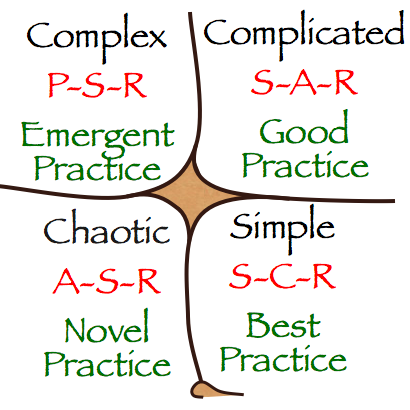
Marketing as a business function always has been perceived by the people working in it as tough. Some might also use the word complex for it. But without knowing what is the actual meaning behind that. In reality complex, complicated are commonly used as a synonym – which in reality couldn’t be more wrong. There is a huge difference between complicated, which means hard to understand but always predictable, and complex which at the core means connected in a un- predicable way.
So why has marketing been more complicated and now moving into the complex state? With the appearing of generative AI models we have per definition complex tools at our hands, that for sure will have huge impact on marketing operations and dozens of processes around out marketing activities. But why is the new form of AI complex? You might already experience for yourself but not put it into this context: ever wondered why the same prompt never gives the same response back? – This is exactly the complexity under such generative AI model work. The output is not any more predictable but probabilistic, which is the new situation we face.
The Cynefin model helps us to understand
A great model to support us in our thinking and problem solutions is the Cynefin framework, created by Dave Snowden in 1999. This framework describes four sense-making environments: simple, complicated, complex, and chaotic.

Simple Environment: In this environment, cause and effect are directly and obviously linked, making it almost perfectly predictable. Anyone can intuitively understand how it works. A visual metaphor is a manual juice squeezer. An example in marketing is a simple automation like sending a standard welcome email upon newsletter signup
Complicated Environment: This environment has many intricately interconnected moving parts that work deterministically, but follow a more complex path. Cause and effect are not as simple as x leads to y; instead, a might lead to x, y, or z depending on intermediate steps. Understanding requires an expert who comprehends the architecture and intricate decision logic. To a non-expert, the outcome might seem random, but it is not. Marketing operations and the martech stack, as it has been structured and operated previously, is a quintessential example of a complicated system. Its logic is deterministic based on how platforms are programmed, configured, and integrated. Due to its size and interconnected parts, a non-expert needs a trained marketing professional to understand its behavior.
Complex Environment: This environment also has many interrelated parts, but they have greater independence, and their interactions are more dynamic and probabilistic. While cause and effect exist, it’s impossible to perfectly predict a specific effect from a specific cause. The visual metaphor is a rainforest ecosystem. Causes lead to effects, which become causes for further effects in a continuous cycle. People can impact a rainforest, acting as stewards and engaging directionally with causes and effects in context, though precise prediction isn’t possible.
Chaotic Environment: This is the fourth environment in the Cynefin framework, where there’s no time for methodical analysis of causes and effects. Action must be taken quickly with limited information. The outcome is unpredictable, but a heuristic can hopefully lead to a good result. In marketing, a completely unmanaged organization with zero governance is essentially a chaotic environment.
AI and LLMs change the game…
The introduction of generative AI and increasingly autonomous AI agents is making marketing more complex. Their generated outputs are probabilistic; the same prompt won’t always yield the exact same answer. If these outputs drive decisions or outcomes, the subsequent chain of events also becomes probabilistic, even if individual steps are deterministic.
Most AI agents rely on LLMs and their reasoning engines for autonomous decisions and actions. These agents are becoming more independent and can interact with each other via protocols like MCP and A2A. This result in complex technical system we are required to use effectively for our purpose. As consequence it requires marketing operations to evolve beyond rigid, linear processes and adapt to a new complexity aware thinking model.
How to adapt
Managing and succeeding in this new complex marketing environment requires new approaches:
- Embrace a modular, loosely-coupled tech & organizational architecture: Favor open, interoperable apps & teams and platforms
- Enhance mechanisms of “observability”: Use logs, dashboards, and anomaly alerts to identify probabilistic outcomes drifting from expected boundaries
- Engage in safe-to-fail experiments: Test new AI agents and capabilities in small pilots to learn their probabilistic behavior
- Institute human-in-the-loop checkpoints: Guard against biased or runaway behaviors for major decisions like audience selection or budget allocation
- Build cross-functional teams: Create small, empowered teams with marketing managers, engineers, AI/ML experts, and compliance to evaluate emergent behaviors and make adjustments
- Invest in greater data maturity: Focus on underlying data infrastructure and pipelines to validate data quality, label drift, and output coherence
- Promote a culture of experimentation: Reward teams for uncovering unexpected failures or novel successes, not just hitting targets
It’s important to note that a complex environment is not an unmanaged environment. It’s simply more probabilistic than the systems of the past few decades. While we still need to orchestrate experiences, the complex stack is likely to have multiple tools orchestrating different contextual experiences, rather than a single master orchestrator. Many new categories of AI agents are emerging, including large AI assistants (ChatGPT, Claude, Gemini), role-specific agents (11x, Rox, Sierra), AI agent builders (CrewAI, agent.ai), web browser agents (Bardeen, Induced, Sola), and frameworks for developers to build their own agents (LangChain, Camel.ai, AutoGPT). This holds a huge opportunity for businesses and their marketing function if they are able to capture it properly for themselves.
Leave a Reply